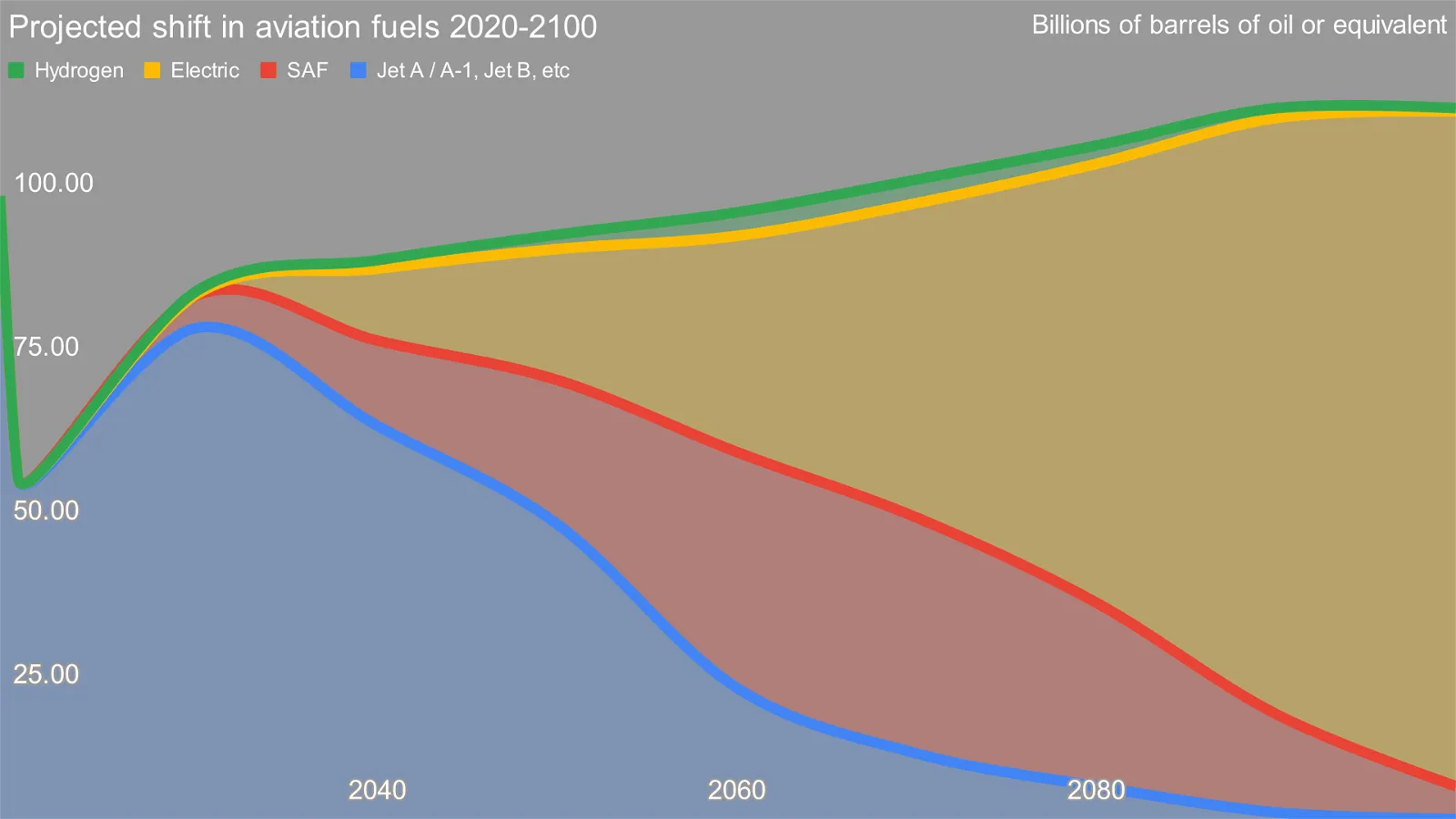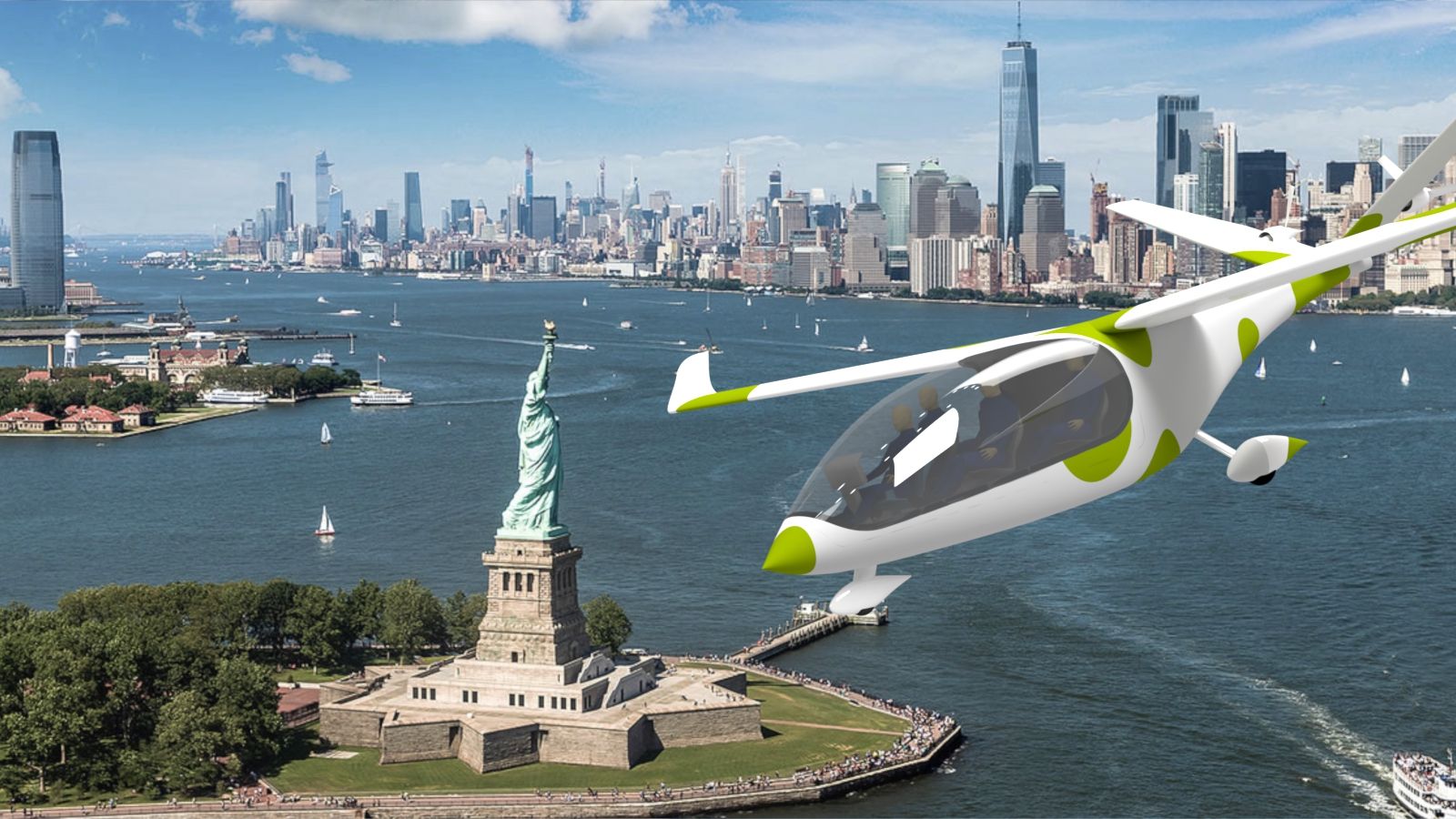Airports Will Increment Solar To Match 12x Electricity Demand By 2100
Recently I published an assessment of whether a reasonably sized international airport, not Heathrow, Chicago, or Changi, but Edmonton YEG’s smaller one, could power all future aviation energy requirements with its 120 MW solar farm. The answer was yes, and more. Of course, that was a thought exercise which had a bunch of bounding assumptions including the viability of long-range electric passenger jets by 2060-2070, so it wasn’t assuming that the solar farm would be powering all aviation out of YEG tomorrow or even in the next 30 years.

But a notional point in time isn’t that useful for airports as they strategize about the coming couple of decades. What will demand look like? When should they expect to see increased electrification in what portions of the airport’s electrical demand?
One commenter on LinkedIn pointed out NREL’s report from late 2021, Electrification of Aircraft: Challenges, Barriers, and Potential Impacts. It’s not bad, although it takes Wright Aerospace’s claims at face value, which is indicative of a certain distance from technical underpinnings (my assessment of Wright’s claims here and here). This is a useful simple diagram that identifies most of the demand loads in an airport, but the report ignores heating, a major current energy demand. The report also doesn’t quantify loads.

It’s worth stepping through the components which will electrify, when that will occur and the likely scale of demand that airports will experience. This perspective is not limited to aircraft, which will be the largest draw eventually, but includes current lighting, baggage handling, air conditioning, heating, customer battery-electric vehicles, and ground support vehicles.

To tease this apart a bit, this is an example of a likely demand curve for Edmonton’s YEG over the next 80 years. Yes, big error bars; this is illustrative and a scenario, not a prediction. And, of course, I could simply be wrong about the ability of large airplanes to fully electrify.
Let’s first identify the components a bit more fully, and the likely path that each will take.
Currently, airports already consume significant amounts of electricity. Benchmarking the size and demand of YEG against Helsinki and San Francisco’s airports, it is likely that YEG is currently drawing 18-19 GWh per year. This would provide all of the electricity for lights, computers, control systems, baggage carousels, ventilation, and air conditioning.
The first component that will add to electrification at airports, something that has already started in the past decade at most of them, is a small number of electric light vehicle chargers for travelers. This is going to ramp up quickly as instead of a handful of chargers in a corner of the lot, customers are going to demand sufficient chargers for them to park in long-term and potentially short term parking and return to fully charged cars. More importantly, all airport cab stands and all car rental lots will need to be electrified to support passenger movement into and out of the airport. All airport shuttles will need charging as well, along with delivery vans and trucks that bring cargo and supplies to and from the airport. Semi-tractors will be charging for 800 km trips at airports, and it’s quite possible that transit authorities will lease charging space at many of them as well. Total demand will be relatively small compared to current load, but it will increase over the next 2-3 decades.
At present most airports use a combination of natural gas boilers including co-generation systems and electric induction heating in specific spots. Airport terminals are huge, exposed, glass boxes and other airport buildings are huge and exposed, just with less glass, so they aren’t trivial to keep comfortable in winter time, but heat removal energy requirements in the summer is likely in the range of heat addition in the winter in temperate climates, as I discovered when looking at carbon neutral, large scale, intensive agriculture greenhouses a few years ago. There will likely be some envelope efficiency upgrades, including better window treatments that reflect infrared in both directions, more roof and wall insulation and slow replacement of major windows with more efficient ones as they require it.
Heating is going to be close to the same BTU requirement as air conditioning in most temperate zones, and that’s one of the largest draws in airports. It will be even higher at YEG, of course, given it’s a bit further north in a colder part of the temperate zone than, for example, Houston. There’s been a great deal of work done to sell and install natural gas co-generation at airports, including YEG where they have three 1.4 MW capacity gas co-gen units. This is claimed as a major efficiency and climate win, but of course is still burning a lot of natural gas, with its upstream fugitive methane emissions. The 4.2 MW of co-generation is likely producing about 1.7 tons CO2 with another 0.8-1.3 tons fugitive methane emissions CO2e per hour for a total of 2.5-3 tons CO2e. And as co-gen mostly runs whether the heat is required or not as it generates electricity that is required and only half the year is heating season, that’s perhaps 22-26 thousands tons of CO2e from their co-gen plant annually.
That’s obviously not a climate solution. What is a climate solution is large scale commercial heat pump deployments. Basically a heat pump is an air conditioner, and so they’ll replace their air conditioners with heat pumps to get both heat services with one set of devices. That will still likely require additional induction heat on the worst days, as it is, after all, Edmonton, where -40° isn’t uncommon and once again it’s a huge glass-walled box as much as anything else. However, a recent heat pump study out of Europe found that even the worst heat pump performances over the course of a year in cold conditions with air source heat pumps had seasonal performance factors (SPF) of 2.0, getting two units of heat energy for every unit of electrical energy provided, which is double the maximum from gas heating. Airports will obviously deploy ground- or water-source heat pumps which even in the worst climates saw SPFs much higher than air-source, in the 3-7 SPF range.
As a side note, this is a place where consumers are not being served well by the heat pump and HVAC industry. A lot of the language is still around coefficients of performance (COP), which is the lab measurement under specific conditions. Some of is it sCOP or COPs, which is to say a lab extrapolation of COP to seasonal conditions. SPF is more European, and measures the actual performance at representative buildings. And in America, there’s HSPF, or heating seasonal performance factor, which remarkably decides to divide BTUs (a thermal unit) by kWh (an electricity unit) to get a completely different and higher range of numbers that is correlated to COP, COPs, and SPF, but much less informative to the average consumer, who doesn’t know what a BTU is. Industry: standardize on language internationally as much as possible so that consumers have a greater ability to compare and contrast as they decarbonize heat.
Heating is the biggest non-aviation increase that will occur, almost doubling total electricity demand at most airports and likely a bit more at YEG, and that is already starting. Vancouver’s airport, frequently a pocket of the future, has installed a large ground-source geothermal installation as part of its decarbonization goals. By 2040, it’s likely that most airports will be converted or well under way.
The next chunk of demand is ground support equipment. That includes the fuel trucks which refuel planes (note that they will be going away over time), the baggage tractors which are already starting to see electrification, pushback tractors, the increasing number of airplane tugs which save taxiing fuel, emergency vehicles, maintenance vehicles, and the like.
Airport ground support equipment fleets are actually an excellent target for early electrification simply because most vehicles, most of the time, are moving slowly on flat surfaces and require significant torque, which plays directly into electric vehicles’ performance sweet spot, so smaller batteries are required than for higher speed road vehicles for similar daily ranges. But ground support equipment is moving quite a bit during the day and the energy requirements to push back an Airbus A321 or to tow it are still very large. After working through all passenger and cargo road transportation that will require charging, my guess at this point is that it will be perhaps double the ground support equipment draw annually, but this is more of a guess than a calculation. Something to look at more closely.
These trends alone basically double airport electricity demand by 2030 and triple it by 2040.

Finally, after already tripling electricity demand, we get to airplanes, which will rapidly become the biggest electricity demand area for airports. As a reminder, my projection of aviation refueling through 2100 has SAF biofuels doing the heavy lifting for aviation demand for long-haul aircraft through 2060-2070, and then a slow decline as traditional jets are replaced by electric aircraft. Where electric aviation will start is with small, conventional takeoff and landing aircraft like FLIMAX’, pictured above, and larger propeller-driven hybrid solutions displacing existing turboprops in the 50-100 passenger range.
Small aircraft are already appearing, and so initial aircraft charging will be at civilian hangers, the FBOs that service them, and the cargo hangars that deal with small planes.
Additional charging will be added to FBOs for larger turboprop charters, gates which service scheduled turboprop flights, and executive jet replacements in the next round. It’s likely main passenger jet gates will start to see MW+ chargers after 2040 for mid-range, 100-200 passenger air travel with new fully electric or hybrid aircraft.
By 2050, airport electricity demand will be in the range of four times as high as 2019 levels, and by 2050, five times as high.
Finally, around 2060 or 2070, main jet airplane passenger jet gates will need MW+ charging for longer haul aviation and electricity demand will really take off. As more and more larger passenger jets are replaced by electric aircraft, SAF biofuels will diminish while annual electricity demand ramps up to roughly 12 times current levels.
This is a generalized pattern for a single, passenger-centric, smaller international airport. There are airports like Ontario International in California which specializes in freight, others that focus on charters to places with sunshine or casinos, others that focus on private jets for the 1%, huge airports like Heathrow, and the like. Each one will have a different path with different increments at different times. I’m currently working on a generalized model and simulation to allow roadmapping of electrification for airports, based on the time and motion simulation capabilities of one of my firm’s simulation engines, currently aligned to commercial building and master planned neighborhoods movement of people, but easily configurable for airplanes, ground support equipment, and ground personnel. Watch this space.
Have a tip for CleanTechnica? Want to advertise? Want to suggest a guest for our CleanTech Talk podcast? Contact us here.
Latest CleanTechnica.TV Videos

CleanTechnica uses affiliate links. See our policy here.

